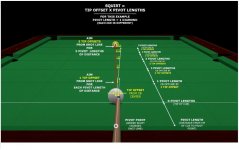Back in the day (60's) I didn't shoot center CB ball for most shots and I never heard of BHE. I commited to memory the effective cut angles that resulted from applying english to the CB and the results of where the CB would hit the rail and spin off of it.
I would see the shot and shape and get down on the shot with the cue to the side of the CB to apply english. if the shot was straight in, I would often use center CB.
20 years ago, I was told that I should learn how to shoot with center CB and memorize the resulting cut angles when aiming with the double distance method (I realized this myself). I knew about swerve (I didn't call it that) and how it could be useful. I didn't conciously allow for squirt (I didn't call it that) for it was incorporated into the resulting cut angles. When I got a new cue, often I would have to relearn the resulting cut angles due to the different squirt characteristics.
I realized that I could start at center of the CB and swipe at it's side with my tip/stroke and effect the desired english. I didn't know about BHE and if I wanted to aim at the side of the CB, I would move my stance to the opposite side a bit or move my bridge (FHE) a bit to the side.
Back in the day, I used a tight bridge with powder. Now I use mostly an open bridge for I can see the top of the shaft for aiming. When I appled english with an open bridge, I noticed that the shaft would move to the side of the "V" as/after the tip hit the CB. I thought that the CB mass was causing the lighter shaft to move to the side or up with follow. I thought that I was getting more spin when the tip glanced/swiped off of the CB.
Everything discussed here is viable (if you understand the words) and one can learn to adjust by HAMB for all of it. If it works for you, you will embrace it, if not you will soon discard it.
Discussing aiming and shooting is percieved differently and is often described differently with different names other than those used here like squirt, swerve etc., and as has been documented and taught. These subjects are not discussed in the pool hall where, "mums the word" or "don't feed the fish."
This in part, is why these instructional forums are usefull and can decrease the learning process. It may not make you a better shooter, but you can at least talk the talk.
Just sayin.

